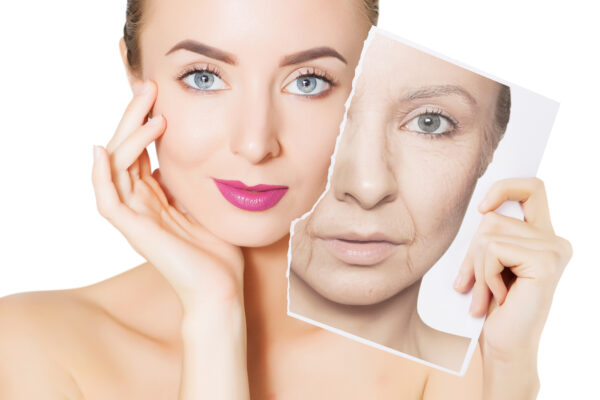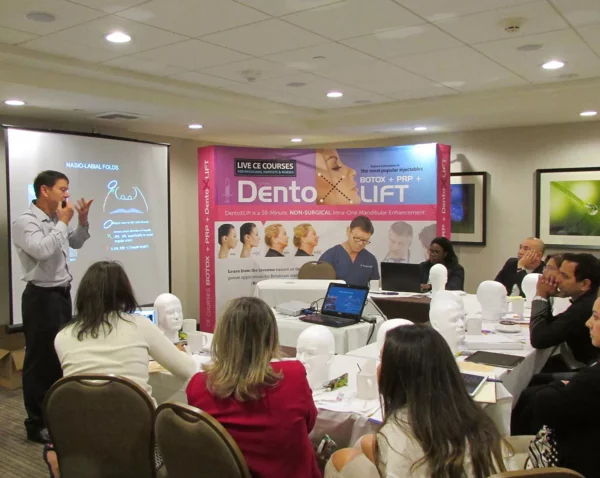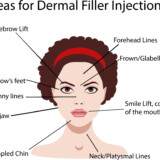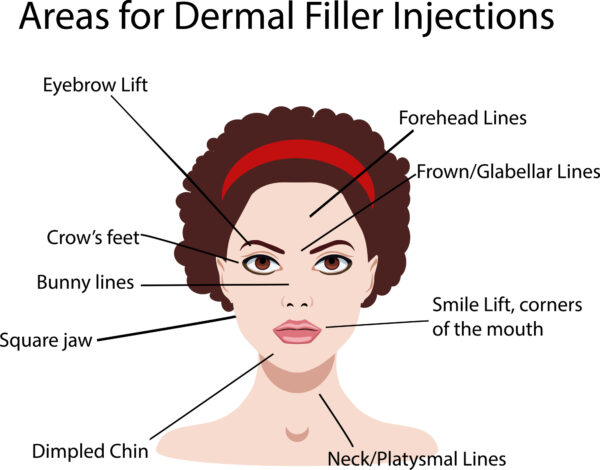The Top Six Reasons Why You Should Get Botox for Wrinkles


By minimizing repetitive motions, Botox treatment is known to have a relaxing effect on muscles, which can help reduce the look of wrinkles.
Botox is a widely recognized cosmetic procedure that has been found to be successful and safe in addressing visible signs of aging. Botox treatment is known to have a relaxing effect on muscles, which can help minimize the appearance of wrinkles by reducing repetitive movements.
The treatment is designed to address the appearance of deep folds by helping to smooth out the skin’s texture. Here are six notable advantages of the Botox procedure for reducing the appearance of wrinkles:
1. Boosts Your All-Natural Charm
One of the notable advantages of the Botox cosmetic procedure is its ability to swiftly enhance one’s inherent attractiveness. The treatment has been found to have potential benefits in addressing signs of aging, as it may help minimize the visibility of wrinkles.
Botox treatment is known for its ability to help relax facial muscles, which can contribute to the appearance of wrinkles and deep lines. The injections have the potential to enhance the appearance of the skin by reducing the appearance of forehead creases, frown lines, and crow’s feet.
2. Alternative to Surgical Wrinkle Removal
Botox is a popular choice among patients who prefer non-surgical treatment alternatives. Instead of employing incisions and anesthesia, the medical professional will utilize injections and numbing agents. For many individuals, this option can be seen as a favorable alternative to extended recovery periods resulting from lengthy procedures. Botox is a widely recognized method of anti-aging treatment that involves temporarily targeting specific facial muscles to achieve desired results.
The treatment tends to show more noticeable effects in facial areas that are subject to extensive muscle use. When the muscles are unable to move, it is possible for facial wrinkles and lines to become less prominent as a result.
The whole process is efficient, with a relatively short completion time, and minimal downtime. One can achieve a youthful look without having to allocate a significant amount of time to their already hectic schedule.
3. Delivers Rapid Outcomes
Injecting Botox is quick, and the effects can be seen almost immediately. It usually only takes a few hours for any minor side effects, like puffiness or redness, to disappear. After receiving the injections, you can resume your regular activities without delay.
When you get cosmetic injections, the lines and wrinkles on your face fade away in just a few days. The aftercare you provide will determine how long the effects will last, but it could be months. Repeated procedures can result in longer-lasting facial rejuvenation. Over time, you can expect a gradual but steady reduction in the appearance of fine lines and wrinkles on your face.
4. Secure Cosmetic Procedure
Getting Botox injections for cosmetic purposes is risk-free if you go to a qualified medical professional. There are no major adverse effects, and the healing process is typically smooth and rapid. You can safely restore your youthful appearance with these injections.
Since only local anesthetic is applied during the procedure, patients report minimal discomfort. The skin on the face will gradually become less wrinkly. The lack of continuous motion is what has led to this development. Botox can also be used to prevent the onset of wrinkles in other areas of the face.
5. Personalized Care Plans
A Botox cosmetic procedure is not a cookie-cutter solution. To achieve the best possible results, you and your cosmetic specialist will work together to pinpoint your specific concerns. They can start with low doses of the injections and gradually increase them as desired.
It is possible that areas with fine lines will only need a few injections while those with deeper, more noticeable wrinkles will need more. Customizable treatments allow professionals to achieve a more natural-looking outcome. You need not fret over taking on a plastic or frozen appearance. The best outcomes can be attained through a collaborative effort with your specialist.
6. Budget-friendly Cosmetic Procedure

When weighed against the price of high-end skincare products or cosmetic surgery, Botox cosmetic treatments may prove to be a more economical option.
Botox cosmetic treatments can offer a cost-effective alternative when compared to high-end skincare products or surgical treatments. The quantity of Botox used will determine the cost of the procedure.
Given the financial resources available, it is possible to consider adjusting the amount of Botox treatment to align with individual preferences and requirements. Botox cosmetic treatment has the potential to provide cost savings by potentially reducing the need for other skin treatment options, such as facials, various wrinkle treatments, or facial surgery. It can be a beneficial approach to consider in order to allocate funds wisely and potentially explore more costly procedures in the future.
Locate a Reputable Botox Treatment Provider
Discover the ideal Botox treatment service provider that can assist you in attaining optimal outcomes. Please take into account the qualifications, experience, patient satisfaction, and safety protocols in order to achieve the most satisfactory results. Select dependable and reputable Botox experienced professionals who possess the necessary expertise to execute the procedure with utmost safety and precision. Experience the unparalleled convenience and remarkable advantages of indulging in Botox treatment today.
Dentox is a training program designed exclusively for medical professionals seeking to master the art of safe and efficient Botox injections. With Dentox, you’ll unlock the secrets to administering Botox with precision, ensuring optimal results while minimizing any unnecessary waste. Experience the unparalleled expertise of Dr. Howard Katz, the visionary leader in the field. Don’t miss out on this incredible opportunity – reach out to us today and embark on a transformative journey.
Experience the ultimate learning journey with our wide range of educational options. Elevate your skills and knowledge by signing up for our exclusive live, online, or on-demand courses. Immerse yourself in a world of learning from the comfort of your own home, or choose to attend one of our captivating seminars held at various locations across the United States. Enroll today and embark on a transformative educational adventure like no other. Immerse yourself in our captivating live courses and explore the convenience of our online programs. Unleash your potential by visiting our website at https://dentox.com/live-courses/ and https://dentox.com/all-courses/ today!
What Education Is Needed to Work in the Field of Aesthetic Nursing?


Aesthetic nurses offer patients specialized treatment in the administration of injectables like Botox and filler, as well as tattoo removal and other cosmetic therapies.
Acquiring the knowledge necessary to enter a specialized field of nursing, such as aesthetic nursing, can be challenging.
When it comes to injecting Botox and filler, erasing tattoos, and other cosmetic therapies, aesthetic nurses provide specialized care. A skilled aesthetic nurse is necessary due to the delicate nature of the job involved. Yet aesthetic nurses come in many forms, each calling for a unique mix of expertise and experience.
What is the training for aesthetic nurses?
Everything a potential aesthetic nurse needs to know is covered in aesthetic nurse training. It comprises your initial RN certification as well as any subsequent certifications, continuing education credits, and on-the-job training.
To become an aesthetic nurse, follow these steps.
-
Certification for New Nurses
To practice aesthetic nursing, you must first become a registered nurse. Achieving this goal is achievable through graduation from a recognized nursing program. Either a two-year Associate Degree in Nursing (ADN) or a four-year Bachelor of Science in Nursing (BSN) program is required to become a Registered Nurse (RN).
After finishing it, you can sit for the National Council of Licensure Examination for Registered Nurses (NCLEX-RN). Your state’s nursing board will grant you a license once you have completed the NCLEX-RN exam required there.
-
Optional Advanced Study
Many registered nurses (RNs) who are interested in aesthetics and cosmetics choose to further their education by enrolling in graduate programs. It takes an additional year or two of graduate study beyond a bachelor’s degree in nursing to qualify for a position as an aesthetic nurse practitioner (MSN).
-
Training for aesthetic nurses
Once you have your RN license, obtaining experience and more education in aesthetic nursing is the next step.
One or more aesthetic services can be your area of expertise. The following are examples of non-invasive, non-surgical services that fall under this category:
- Patient Consultations: Arrange an appointment time, talk to the client, and perform any necessary health checks before beginning any cosmetic procedures.
- Examinations of the Skin: Evaluating Skin Health and Age to Determine Treatment Needs
- Patient Care: Provide pre- and post-operative treatment.
- Physician Assistance: Give a hand to physicians during Procedures or surgeries.
- Equipment Prep: Sterilize and Set Up Operating Rooms
- Cosmetic services: Administer Botox and filler injections; chemical peels; dermabrasion; CoolSculpting; and hair and tattoo removal using lasers.
Having at least two years of experience is typically a prerequisite for certification and employment. The easiest way for an aesthetic nurse to gain experience is to work with a doctor who is a board-certified physician in one of the following specialties:
- Plastic surgery
- Aesthetics
- Cosmetic surgery
- Dermatology
- Ophthalmology
-
Taking Courses in Aesthetic Nursing
If you wish to provide aesthetic services, you can hone your abilities through online and in-person training.
For every type of aesthetic service, courses for aesthetic nurses are available at all levels. The education they provide begins with the fundamentals and progresses to certifications and advanced techniques.
Continuing education courses also help you maintain your skills and stay updated on emerging technologies and techniques in this innovative and swiftly evolving field.
-
Earning Certifications as an Aesthetic Nurse
Certification is the pinnacle of aesthetic nursing training and a sign of professionalism.
There are four different aesthetic nursing certifications that validate expertise in distinct fields. There are four primary aesthetic nursing credentials, and they are:
- Certified Aesthetic Nurse Specialist (CANS)
- Certified Plastic Surgery Nurse (CPSN)
- Dermatology Nurse Certified (DNC)
- Dermatology Certified Nurse Practitioner (DCNP)
Training Nurses to be Botox Injectors

Dentox is a program designed to educate medical practitioners on the proper use and administration of Botox injections.
Botox and similar injectables have several medical uses, including the treatment of wrinkles and frown lines, chronic jaw pain, migraine headaches, and more. Aesthetic registered nurse training that focuses on injectables covers:
- Anatomy
- Assessment
- Dosing
- Patient safety
Dentox is a training program for medical professionals that teaches them how to inject Botox correctly and safely. Learn the latest techniques for improving your patients’ physical and mental health so you can offer them the best care possible. Learn more about the virtual and in-person patient training sessions at https://dentox.com/all-courses/botox-training and https://dentox.com/live-courses.
What drives the large percentage of young people who get Botox?


At 30, people may be bombarded by Botox and filler ads.
Prejuvenation treatments are becoming more popular among young adults.
A rather peculiar occurrence may have transpired as individuals reach the tender age of 30: they may find themselves inundated with advertisements promoting the wonders of Botox and fillers. Their media pages are absolutely brimming with stunning before-and-after snapshots showcasing flawlessly smooth skin, gorgeously plumped lips, exquisitely sculpted cheekbones, impeccably arched eyebrows, the most exquisite buccal fat removal, and an endless array of captivating cat-eyed, concave-contoured “Instagram Faces” that defy gravity by effortlessly going “up” instead of the ordinary “down”. A video on TikTok this week has enlightened us about the possibility of injecting Botox into the shoulders, thereby creating the illusion of a more petite frame in photographs.
Although widely used, with approximately 900,000 Botox injections performed annually in the UK, the aesthetic injectables industry lacks sufficient regulation. According to a recent study, it has been observed that over two-thirds of cosmetic practitioners responsible for administering injections lack the necessary qualifications as medical doctors. It is important to note that people with a variety of backgrounds can administer filler injections. Currently, there is a lack of national minimum standards for professional training or regulated qualifications, resulting in the availability of Botox treatments through unconventional channels such as hair salons, beauty apps, or Snapchat stories.
The precise number of individuals who choose to undergo fillers is difficult to determine, but it is estimated that around 4.3 million people opt for this procedure annually. Furthermore, the age demographic has yet to be determined; nevertheless, it is important to bear in mind that it is presently against the law to provide treatment to individuals below the age of 18.
There are inherent risks associated with the procedure, including but not limited to pain, headaches, swelling, bruising, infection, temporary facial paralysis, and the potential for facial disfigurement. However, despite the numerous accounts of adverse effects such as sagging eyelids and partially immobilized facial muscles, the need for injectable “treatments” remains on a rapid upward trajectory. This trend is particularly evident among individuals in their twenties, who are increasingly choosing to undergo “prejuventation” treatments or “Baby Botox” as a proactive measure to prevent signs of aging.
Two decades ago, plastic surgery was commonly regarded as a significant and transformative procedure. The procedure was notable for its high cost, protracted effects, and intrusive nature. It frequently involved a post-operative phase that included blood-soaked dressings and bruising around the eyes, which caused discomfort for the patient. In contemporary times, a growing number of young individuals perceive fillers as akin to routine grooming practices such as haircuts or manicures, thereby considering them an additional facet of their personal self-care regimen.
The notion of cognitive reframing suggests that injectables should not be perceived solely as a means of enhancing one’s appearance but rather as a form of self-affirmation. However, this perspective is deemed laughable by experts in the field. Adolescents, who have been exposed to a highly curated digital environment where they can easily manipulate their appearance with a simple click, are being advised to prioritize their personal happiness by the same entities that contribute to their deep-seated insecurities and dissatisfaction.

Kylie Jenner is a public figure who has been linked to the widespread use of lip fillers.
When individuals are consistently exposed to the notion that natural appearances are deviating from the norm and that possessing silicone enhancements has become a symbol of social status, coupled with the prevailing idea that one can attain a resemblance to Kylie Jenner, a prominent figure associated with the proliferation of lip fillers, for a relatively modest sum, it is only natural for them to be enticed by the allure of dopamine-induced euphoria and the prospect of perpetual youthfulness.
The trouble is, once you start down that path, it’s almost impossible to turn back. Because Botox and fillers are eliminated from the body after three to six months, patients must schedule regular touch-ups to sustain their rejuvenated appearance. It’s an ideal substance for new users to try. These days, altering one’s outward appearance is a simple process. Follow, filter, and filler is an appealing pipeline.
The prevalence of Love Islanders who have undergone extreme makeovers makes it interesting to see how our culture promotes cosmetic interventions as desirable. However, it is paradoxical that we simultaneously condemn gender-affirming surgery by labeling it “mutilation.” Indeed, the latter option entails a significantly higher degree of severity, intrusiveness, and permanence.
However, it is crucial to recognize that both alternatives stem from a fundamental discontentment with one’s body image and a sense of dysphoria. This stems from the belief that by altering our external appearance, we can attain a heightened sense of self-worth and contentment internally. The proposed approach can be considered a cosmetic remedy for a psychological issue. Gender-affirming care is subject to rigorous regulation, ensuring that it adheres to stringent guidelines and thresholds. Unfortunately, the injectables industry is not in a favorable state.
Experience the extraordinary potential to revolutionize the lives of your patients with Dentox’s all-encompassing education and training program. As a medical professional, you are presented with an unparalleled chance to make a profound impact. With our expert guidance, we guarantee a flawless journey toward achieving your dream cosmetic objectives, leaving you worry-free every step of the way.
Discover the ultimate destination for an extensive array of cutting-edge distance learning programs. Look no further than our exceptional website at https://dentox.com/all-courses/botox-training/. Also, experience the ultimate in hands-on learning with our live patient courses at Dentox. Find the extraordinary opportunities that await you at https://dentox.com/live-courses/.
A Survey Finds That Just One-Third of Injectors in Cosmetic Surgery in The UK Are Non-Doctors

A new study reveals that more than two-thirds of the people in the United Kingdom who are injecting patients with substances like Botox for cosmetic purposes are not medical doctors.
This research is the first survey of the professionals who administer Botox and other injectable fillers for cosmetic purposes.
The industry cannot be properly governed without identifying the academic and professional backgrounds of practitioners.
Researchers from UCL combed through 3,000 websites to learn about the education, training, and experience of people delivering treatments.

Researchers from UCL combed through 3,000 websites to gather information regarding the education, training, and experience of those providing treatments.
They found 3,667 individual doctors and 1,224 independent clinics that performed cosmetic injections.
There were 32% doctors, 13% nurses, 24% dentists, and 8% dental nurses in terms of the professions represented.
The research showed that out of the 1,163 doctors counted, 41% were specialists and 19% were general practitioners.
Among the 27 specialties represented on the specialist register, the survey revealed that plastic surgery made up the largest group (37%), followed by dermatology (18%).
The market for cosmetic injectables in the United Kingdom faces well-documented challenges that have not yet been addressed.
Without greater information about the practitioners’ educational and professional backgrounds, the industry cannot be adequately governed.
The vast majority of practitioners are not medical doctors but rather other types of healthcare workers or even non-medical workers like estheticians.
The diversity of backgrounds raises a broader issue of competence and consent.
Making sure that licensed professionals have the knowledge and experience to provide care in a way that minimizes harm to patients is a major problem for the government’s licensing process.
A patient’s informed consent hinges on their trust that the healthcare provider performing their procedure is qualified to do so.
This study fills in some of the blanks for regulators and patients, providing valuable information as the UK strives to make the cosmetic injectables market safer and more open.
The study predicts that the value of the UK injectables industry will reach £11.7 billion by 2026, yet the market is currently unregulated.
The government of the United Kingdom is currently revising its injectables policy and will launch a public consultation on the industry in August 2023. In 2024, the Medical Act is scheduled to be revised in light of the recommendations made in this report.
Rapid growth has been seen in the cosmetic injectables market in the United Kingdom in recent years. There hasn’t been much in the way of monitoring or investigation into this.
The results should serve as a wake-up call to policymakers, prompting them to enact regulations and professional standards that adequately protect patients from harm.
Although most injection-related hazards are very minor and short-lived, some of the physical problems can be lifelong and severely limiting.
When medical procedures go wrong, patients may suffer not only physical harm but also significant mental and financial distress.
Until recently, there has been a lack of data on the frequency of problems and the effect they have on patients, as well as the qualifications of those administering cosmetic injections.
On July 3rd, the results of another study were published, showing that 69% of respondents had experienced chronic side effects such as pain, anxiety, and headaches.
Dentox is a course designed to teach healthcare professionals how to administer Botox to patients in the most secure and efficient way possible. Online classes can be found at https://dentox.com/all-courses/botox-training/, and courses with actual patients can be found at https://dentox.com/live-courses/.
Trend of “tweaks” in the UK—What to watch out for with Injectable Cosmetics


Botox and dermal fillers, among other non-invasive cosmetic procedures, are becoming increasingly popular in the UK.
Who among us doesn’t have a few imperfections that we may consider addressing through cosmetic procedures? For individuals interested in enhancing their complexion or achieving fuller lips, “tweakments” could potentially offer a solution.
Non-surgical cosmetic procedures, including Botox and dermal fillers, are experiencing growing popularity in the UK. According to a cosmetic medical professional, there has been a significant increase in demand for procedures at his practice, estimated to be at least 50%, following the conclusion of the COVID lockdowns.
Based on a recent UCL study, it is projected that the UK injectables market will possibly hit a value of £11.7 billion by 2026. However, it is worth noting that the current regulatory framework for this market is not fully established.
In this instance, we provide an overview of important considerations to keep in mind prior to scheduling a “tweakment”.
How can you be sure that you are receiving treatment from the most qualified professional?
In the United Kingdom, injectors come from a variety of backgrounds, from medical professionals to those without a medical background, making research crucial.
First and foremost, you need to know that they are qualified to perform the procedure in question, that they have received adequate training for it, and that they have a plan in place for handling complications should they arise.
The injector should also be prepared for and know how to treat any complications that may arise, even minor ones like pain, redness, and swelling.
To avoid rushing into treatment, it is important to compile a list of practitioners you are interested in seeing and might be able to trust, but this does not mean you should immediately schedule appointments with them.
Feel free to ask your injector lots of questions about their background and how they dealt with complications in the past.
The growing popularity of “tweakments” highlights the need to educate the public on how to locate a qualified practitioner.
Dentox is a comprehensive training program designed to provide medical professionals with the necessary skills to effectively administer Botox injections. Please consider visiting the following links for additional information on patient training programs: https://dentox.com/live-courses/ for live classes and https://dentox.com/botox-training/ for virtual classes.
What are the limitations on who can perform these procedures?
As it stands, there is no hard-and-fast rule in the UK about who can provide these treatments.
According to a recent study by researchers at University College London (UCL), about two-thirds of those in the United Kingdom who inject patients with drugs for cosmetic procedures like Botox are not trained physicians.
The research study, which has been published in the esteemed Journal of Plastic, Reconstructive & Aesthetic Surgery, represents the initial survey conducted to identify the providers of cosmetic injectable services, such as botulinum toxin (Botox) and dermal fillers, within the nation.
Researchers from UCL conducted a comprehensive analysis of 3,000 websites to gather information on the background qualifications, training, and experience levels of individuals involved in administering treatments.
A total of 1,224 independent clinics and 3,667 practitioners were identified as providers of cosmetic injections. Among the various professions represented, a significant proportion (32%) consisted of medical doctors, while nurses accounted for 13% of the group. Additionally, dentists made up 24% of the professionals, with dental nurses comprising 8% of the total.
According to experts, it is important to consider the professional backgrounds of practitioners in order to effectively regulate the industry.
However, one of the key concerns regarding the current legislation is the need to ensure a high level of competence in administering the injections.
Competence plays a crucial role in effectively recognizing and managing potential complications, should they arise.
These injections, like any medical procedure, carry the potential for complications. While most complications are typically mild and temporary, there is a small risk of long-lasting and significant effects.
What measures is the government taking?

The UK government is currently reviewing potential changes to its injectables policy.
The UK government is currently in the process of considering updates to policy regarding injectables, and they are planning to initiate a public consultation on the matter starting in August 2023.
It is anticipated that recommendations will be considered in order to inform potential amendments to the Medical Act in 2024.
In addition to considering the professional background of individuals administering cosmetic injections, it is worth noting that there has been barely any study conducted on the occurrence of complications and their effects on patients until lately.
In 2013, the government sought the expertise of a Professor to conduct a comprehensive review of the regulations pertaining to cosmetic interventions. In his report, the former NHS England National Medical Director expressed the view that individuals seeking non-surgical cosmetic interventions may have limited avenues for protection and redress, similar to those purchasing everyday consumer products such as ballpoint pens or toothbrushes.
He suggests that there was a missed opportunity ten years ago when the recommendations outlined in his report were not implemented through legislation.
He expresses optimism that potential government intervention in the UK will have a positive impact on enhancing and safeguarding patient safety while also ensuring that appropriate measures are in place to address any unfortunate incidents.
One potential resource that the government may consider when evaluating the qualifications necessary for administering these treatments is the set of recommendations outlined in the 2015 Health Education England framework.
There is a desire among individuals for the standardization of training in this field. It is believed that having a qualification or a similar requirement would be beneficial in ensuring the competence of those performing the treatments. It would be beneficial for the industry to consider implementing regulations and advocating for aesthetic medicine to be recognized as a specialized field.
A Professor from the UCL Global Business School for Health, who co-authored the UCL study, mentioned that the UK cosmetic injectables industry has experienced significant growth in the past few years. This has occurred with limited scrutiny or supervision.
The findings of the study suggest that there is an opportunity for legislators to consider implementing efficient legislation and professional standards that could potentially enhance patient safety and reduce complications.
While it is true that injections can carry some risks, it is important to acknowledge that these risks are typically mild and short-term. However, it is also important to consider that in certain cases, there is a possibility of experiencing physical complications that could have long-lasting and significant effects.
Why is “Barbie Botox” so popular on TikTok? Learn the ins and outs of the newest fad in cosmetic injectables


Barbie Botox has won praise for its capacity to trim the neck, resulting in shoulders that nearly resemble those of the well-known Barbie doll.
When it comes to grooming, many people enjoy incorporating elements of their favorite characters or themes into their routines. From using a Barbie pink hairbrush to applying makeup in the iconic doll’s color palette, there are various ways to add a touch of fun and nostalgia to your daily grooming rituals.
Barbie Botox has been receiving accolades for its ability to slim down the neck, resulting in a shoulder profile that closely resembles that of the iconic Barbie doll. The procedure in question has managed to capture the attention of beauty influencers while simultaneously raising concerns among body image experts.
The phenomenon that has amassed over 2 million views and is steadily gaining traction on TikTok has captured the interest of professionals in the field. Let us explore this viral phenomenon, shall we?
What exactly is Barbie Botox?
Barbie Botox also referred to as trapezius Botox or “Trap Tox,” has gained significant recognition through the efforts of social media influencer Isabella Lux. The procedure being described involves the administration of Botox, an FDA-approved neurotoxin that functions by impeding muscle contraction. Specifically, the injection is targeted at the trapezius muscle, which is located between the neck and shoulder.
While it can help alleviate tension in the neck, the primary motivation for the “Barbie Botox” fad appears to be superficial; relaxing the shoulder muscles creates an elongated neck and softer shoulders, making the patient look like Barbie. No matter how hard you look, you will not find any trapezius muscles on a Barbie.
According to a Beverly Hills-based plastic surgeon, “Botox in the trapezius decreases excessive muscular tone and look.”
Although the cosmetic procedure may be popular right now because of Barbie, doctors claim that using neurotoxin injections to relieve pain has been practiced for many years.
A facial plastic surgeon noted, “This has been utilized in neurology for no less than twenty years in the scalene and trapezius muscles.” For the past ten years, she claims, “it has only been utilized in an aesthetic sense.” She notes that over the course of the past month alone, trapezius Botox has grown immensely popular among her patients, a phenomenon she relates to the ability of social media to create trends.
The plastic surgeon says she receives no fewer than one initial consultation for trapezius Botox every day, usually with women between the ages of 30 and 50. “I’ve been doing it for the last 10 years, but it’s famous now since people realize they have an alternative to obtaining a long, slenderized neck,” she adds. Hence, she explains, “Approximately half the patients come for beautification and desire that look of the Barbie neck, whereas the other half come for neck muscle problems.”
What is the procedure for Barbie Botox?

Botox injections in the trapezius reduce excessive muscle tone and appearance.
Similar to standard facial Botox, the trapezius Botox procedure is individualized for each patient. However, the general procedure is quite consistent, as the plastic surgeon says she usually starts with a physical examination, carefully palpating the muscle to determine where all the stress and mass are.
A doctor performs injections after mapping the area. She adds that the procedure, which uses other FDA-approved neurotoxins like Dysport and normally costs between $900 and $1,500, may be completed in as little as 10 to 15 minutes and involves roughly four to five injection spots.
According to some clients, the discomfort from the injections is worse than the facial Botox. Lux, who first learned about trapezius Botox on TikTok and was determined to give it a try, said that there were such big volumes going into each muscle that you could actually feel it in the muscle. “I’m about to tie the knot. So I told myself, “This is the time.”
A beauty marketing specialist and content creator from Austin, Texas, says she received Barbie Botox injections so she could look more feminine.
While everyone is different, the neurotoxin usually begins to take effect within a week, and the slimming impact can occur anywhere from weeks four to six. The effects ought to stick around for four to six months.
What possible negative outcomes are there?
Specialists recommend seeing a healthcare professional, as with any cosmetic treatment and mention that there may be some transient swelling or soreness after the injections.
Due to the proximity of critical nerves, such as the entire cervical plexus and the brachial plexus, which directs the arms and the neck, it is essential to seek the care of a qualified medical practitioner. Muscle weakness might occur if the injection is given too deeply or not properly.
Attempting to have a Barbie-like appearance is not without psychological hazards.
Dolls like Barbie serve as symbols. According to a USC professor who studies gender and sexuality, Barbie is merely a representation of an abstract concept. She argues that emulating Barbie’s ideal of beauty is unattainable.
She asserts that the pressure women feel to conform to unrealistic beauty standards set by Barbie can lead them to have a bad self-image.
This is in line with the centuries’ claims that playing with Barbie dolls (at least the ones without a wide range of body types) can cause girls to have body image issues, as well as studies showing that girls who play with skinny dolls, in general, are more likely to feel body dissatisfaction.
It is imperative to acknowledge the importance emphasized by experts that Barbies are, in essence, mere playthings.
Dentox is a comprehensive training program designed to provide medical professionals with the necessary knowledge and skills to administer Botox injections to patients in an efficient and risk-free way. Courses involving live patients can be accessed through the website https://dentox.com/live-courses/. Alternatively, if you prefer online options, you can explore the offerings available at https://dentox.com/all-courses/botox-training/.
Managing the Process of Filler Migration and Dissolution


Filler migration can be prevented by selecting an injector who has the appropriate training and experience.
Dermal fillers have gained popularity in recent years as a non-invasive method of improving a number of cosmetic issues. Although injectable therapies can have spectacular effects, filler migration is a risk that patients take. When filler material injected into one area spreads to another area, it is said to have migrated. Understanding this occurrence and being cognizant of the significance of dissolving fillers when required have thus become crucial.
Why dissolving fillers are growing in popularity
The rising demand for dermal fillers has resulted in an increase in the number of injectors without sufficient experience carrying out these treatments. It is possible for the danger of filler migration to drastically increase in the absence of appropriate training and skills. In addition, there is a possibility that some people will not be pleased with the outcomes or will encounter unwelcome side effects. In order to remedy these difficulties and restore a natural appearance, dissolving fillers has become an increasingly prevalent practice.
Filler migration: what you need to know
Improper placement or technique, utilizing the wrong filler type, or administering too much product in a single treatment session are all potential causes of filler migration. Filler migration can also be caused by factors like aging, changes in facial volume, and personal anatomy. To reduce the possibility of filler migration, it is essential to work with an experienced injector who is familiar with facial structure.
Selecting a competent injector
Choosing an injector with the necessary training and experience is crucial for controlling filler migration. Look for a medical professional, dermatologist, or plastic surgeon who has completed further training in injectable procedures, such as a Certified Aesthetic Nurse Specialist. To reduce the possibility of filler migration, they have the training and experience to assess your individual facial structure, choose the best filler products, and inject them precisely.
Handling the migration of fillers
In the event of filler migration, it is crucial to discuss with a medical professional dissolving filler options. The enzyme hyaluronidase is widely employed for this purpose since it degrades hyaluronic acid fillers. A trained professional can inject hyaluronidase to dissolve the migrating filler. Expertise is needed to dissolve fillers safely and effectively, and numerous treatment sessions may be necessary to get the desired results.
The use of dermal fillers is on the rise, but with this trend comes the risk of problems such as filler migration. Managing and correcting any unfavorable consequences requires selecting a competent injector and learning about the dissolution process of fillers. Individuals can get the benefits of fillers with minimal migration concerns by prioritizing safety, communication, and aftercare.
Keep in mind that you have control over your look, and the best results may be achieved by making well-informed choices. Botox treatment can be the best option for a significant and swift transformation.
Dentox is a program for healthcare professionals that teaches them how to safely inject Botox. Learn cutting-edge techniques that will help you better the lives of your patients. You can find both online and in-person patient training classes at https://dentox.com/all-courses/botox-training/ and https://dentox.com/live-courses/, respectively.
Can I Trust My Dentist With a Botox Cosmetic Procedure?


Dentists go through extensive training to become proficient in the use of Botox, which they can use to alleviate their patients’ painful symptoms.
At contemporary dental establishments, an extensive array of services is offered, surpassing the conventional expectations associated with such establishments. In the current era, Botox has gained significant recognition as a highly innovative dental treatment option. Discover the myriad benefits associated with the utilization of Botox for cosmetic tweaks.
What Conditions Are Treatable with Botox?
Dentists receive specialized education to ensure they can provide effective Botox treatment to their patients, which can reduce uncomfortable symptoms. Here are a few problems that can be fixed with Botox:
- Discomfort in the Temporomandibular Joint (TMD). When a patient suffers from TMD, they may experience pain because their muscles are tense and strained from overuse. Botox treatment is useful for relieving jaw tension because it relaxes the muscles that cause the jaw to move subconsciously, thereby reducing the associated pain and headaches.
- Bruxism. Bruxism, or the habit of clenching and grinding one’s teeth without realizing it, is a serious medical condition associated with significant tooth wear and other unpleasant side effects. Botox treatment for bruxism has similar effects on sufferers as it does on those with TMD.
- Lowering a Prominent Lip Line. Lowering a high lip line with Botox is a non-invasive alternative to crown lengthening or gingival surgery. It will make the patient’s smile more attractive by getting rid of the “gummy smile.”
- Edentulism. Those who suffer from this condition have few or no teeth left. These people can strengthen their lip muscles with the help of Botox injections.
For What Reason Should You Visit a Dentist for Botox?
When Botox is administered using appropriate techniques, the occurrence of risks or adverse side effects is nearly negligible. It is strongly advised to refrain from receiving Botox treatments from individuals who lack proper certification as healthcare providers and appropriate training. Engaging in such activities may potentially expose individuals to the possibility of facial nerve damage and ocular complications.
Is Botox a Good Choice for Me?
If you are currently experiencing chronic pain resulting from jaw tightness or migraines, or if you have concerns regarding your facial structure due to missing teeth, we are pleased to inform you that Botox may present a viable solution to address your particular concerns.
The administration of Botox treatment has the potential to enhance one’s youthful appearance by reducing the visibility of fine lines and wrinkles. Additionally, this procedure can contribute to the improvement of skin elasticity and overall radiance. This treatment can effectively reduce the appearance of wrinkles and other indications of aging. Proper preparation and post-treatment care can be effectively accomplished with the support of a dependable service provider. Please reach out to a certified Botox expert to initiate a comprehensive discussion regarding your treatment options and schedule a convenient appointment.
Professionals specializing in the medical and aesthetic fields can acquire valuable knowledge and skills from Dentox on the safe and efficient administration of Botox. We offer the opportunity to attend classes at multiple convenient locations throughout the United States. Alternatively, you can also take advantage of our flexible online learning options, which allow you to learn at your own pace and convenience. For information on our in-person courses, please visit the website: https://dentox.com/live-courses/. If you are interested in our virtual courses, you can find more details at: https://dentox.com/all-courses/botox-training.
Life Hack: Recovering Quickly From Botox Treatment

When patients get Botox injections, they can get the best possible outcomes by following the aftercare guidelines. It also helps prevent Botox from spreading to other areas and causing bruising.
Light face workouts in the morning before getting Botox are encouraged, as is taking it easy for the remainder of the day, maintaining a normal blood pressure and heart rate, and not touching, rubbing, or putting any physical pressure on the treated region.
As an added convenience, we have included some helpful guidelines for recovering from Botox treatment.
Care instructions for Botox patients
If you want to make sure you get the most out of your Botox treatment, make sure you follow these guidelines.
Please refrain from working out for 24 hours

Exercise boosts circulation. Doing so may cause Botox to travel to unintended locations and lose part of its efficacy.
For at least a day, you should not engage in your typical physical activity. Your doctor might advise a few days of waiting.
Exercise improves blood circulation. By doing so, the toxin might end up in places it was not intended to go and lose some of its potency where it was injected. Additionally, it makes bruising more likely.
Muscle contraction during exercise has also been linked to reduced Botox efficacy.
On the other hand, it is perfectly safe to practice making angry, happy, and perplexed facial expressions.
These actions may hasten the onset of Botox’s beneficial effects.
Do not wear makeup for a while
Makeup applications should be put on hold for at least 24 hours after receiving a Botox injection. When you apply makeup, you will be rubbing the skin, which may cause the toxin to become more widespread.
Sit up
For the first four hours following Botox treatment, sitting up straight is advised. By bending over or lying down, the toxin could spread, and bruises could get worse.
Discuss medication options with your doctor
You could bruise more easily if you take certain medicines. Make sure to inquire with your physician regarding the appropriate time to resume taking them.
Aftercare precautions
It is important to take care of yourself after getting Botox injections. Please remember the following details on the day of your surgery.
Put down the liquor
Alcohol should be avoided for 24 hours prior to receiving Botox. Having a few drinks can make bruising more likely.
This is true both before and after a course of treatment has been completed. After obtaining an injection, you shouldn’t partake in alcoholic beverages for at least a day.
Avoid making facial contact
In order to avoid spreading any kind of infection, refrain from touching your face for at least 24 hours. Several medical professionals believe that this period should continue until the third day.
If you have had Botox elsewhere on your body, you should follow the same precautions.
Expert massages of the affected areas are included. Although getting a massage is helpful, you should wait a few days before making an appointment.
Steer clear of any other skin treatments

Following your botox treatment, it is highly recommended to observe a waiting period of 24 hours before engaging in any facial procedures such as facials, facial massages, exfoliating scrubs, or dermal fillers.
The effects of Botox on the muscle will not be felt immediately. You should wait 24 hours before getting a facial, facial massage, exfoliating scrub, or dermal fillers.
If you get these procedures too soon after receiving injections, their efficacy may suffer.
Avoid getting any sleep in the treated areas
The injected areas should be avoided at all costs when sleeping. This will reduce the amount of force exerted on the muscles and allow the Botox to take effect more quickly.
In addition, when your treatment is complete, you should wait at least four hours before going to bed.
Keep out of the sunlight
Try to stay out of the sun for at least four hours. Flushing and higher blood pressure are both side effects of being in a hot environment, and both can contribute to an increased risk of bruising. For maximum safety, avoid direct sunlight for twenty-four to forty-eight hours.
The use of tanning beds, hot tubs, hot showers/baths, and saunas is also discouraged.
When to Seek Medical Attention
Mild discomfort, redness, and swelling are common responses to Botox treatment. Commonly, you can expect to feel normal again after a day.
Bruising is yet another negative effect that frequently occurs. An ice pack on the affected area may provide some short-term relief. Bruising usually disappears after two weeks.
But if you suffer any of the following symptoms, you should seek medical attention:
- muscle weakness
- swallowing issues
- speaking challenges
- breathing difficulties
- dysfunctional bladder control
- vision changes
Although uncommon, these negative reactions require prompt medical attention.
Takeaway

If you have questions, ask your medical professional about post-Botox activities. Your post-treatment care will be personalized to your needs and habits.
Botox can be administered in the office of a medical expert. After that, you could just go home, but you need to take care of yourself as per the usual procedure for recovering from Botox. This is crucial for achieving the greatest results.
Discuss your post-Botox activities with your physician if you have any concerns or questions. Advice on how to care for yourself after treatment will be tailored to your individual needs and habits.
With Dentox’s comprehensive education and training program, you, as a medical professional, have the remarkable opportunity to truly transform your patients’ lives. By skillfully assisting them in attaining their desired cosmetic goals, you can ensure a seamless experience devoid of any concerns.
For a comprehensive selection of online classes, we kindly direct you to our website at https://dentox.com/all-courses/botox-training/. Alternatively, if you prefer a more hands-on approach with live patient courses, we invite you to explore the exceptional opportunities available at https://dentox.com/live-courses/.
Men in South Africa wait in line to get Botox and fillers


South African males are increasingly using Botox and fillers to fight aging and improve their appearance.
Increasing numbers of men in South Africa are turning to injectables like Botox and fillers to combat the visible signs of aging and enhance their appearance. This trend mirrors a global trend as more and more individuals seek out both temporary and permanent solutions in their pursuit of beauty.
Cosmetic surgery and non-surgical aesthetic treatments increased by 29% between 2000 and 2018, while botulinum toxin injections for men increased by a staggering 182% during the same time period.
According to News24, an expert in aesthetic medicine in the Western Cape said he wasn’t surprised by the growing trend among young guys.
Because of social media, virtual meetings, and the media’s emphasis on outward appearances, “Gen Z and millennials seem to be more likely to put an emphasis on self-care and self-improvement than prior generations,” he remarked.
He noted that crow’s feet and forehead wrinkles are two of the most frequently addressed cosmetic concerns among males, with the latter typically growing earlier and deeper in men due to behavioral and hereditary causes.
Botox is just one of many medicines and procedures used to target the underlying muscles responsible for wrinkle formation and relax them. Twenty years after receiving FDA approval in the United States, Botox cosmetic treatments are still commonplace.
The use of lip filler by males seeking a more youthful appearance has also increased, and a properly performed liquid rhinoplasty may produce success comparable to that of surgical rhinoplasty.
Those seeking a temporary change or correction who are unwilling to undergo plastic surgery frequently opt for this method.
He continued by saying that dermal fillers can temporarily alter the appearance of a person’s nose, but that subsequent treatments will be needed every 18 months or so.
He also added that while soft tissue fillers can’t change the overall size of the nose or fix a deviated septum, they help smooth out bumps, indentations, asymmetry, and even elevate the tip of the nose.
Dentox is a program designed to provide comprehensive education to healthcare professionals on the optimal techniques for administering Botox injections. Our program is specifically designed to equip you with the knowledge and skills necessary to excel in this specialized field of aesthetic medicine.
Visit https://dentox.com/all-courses/botox-training/ to learn more about our online course and improve your knowledge and competence. For those looking for the unmatched experience of live patient training sessions, we cordially encourage you to visit https://dentox.com/live-courses/ to get useful information and reserve your place in these life-changing sessions.





